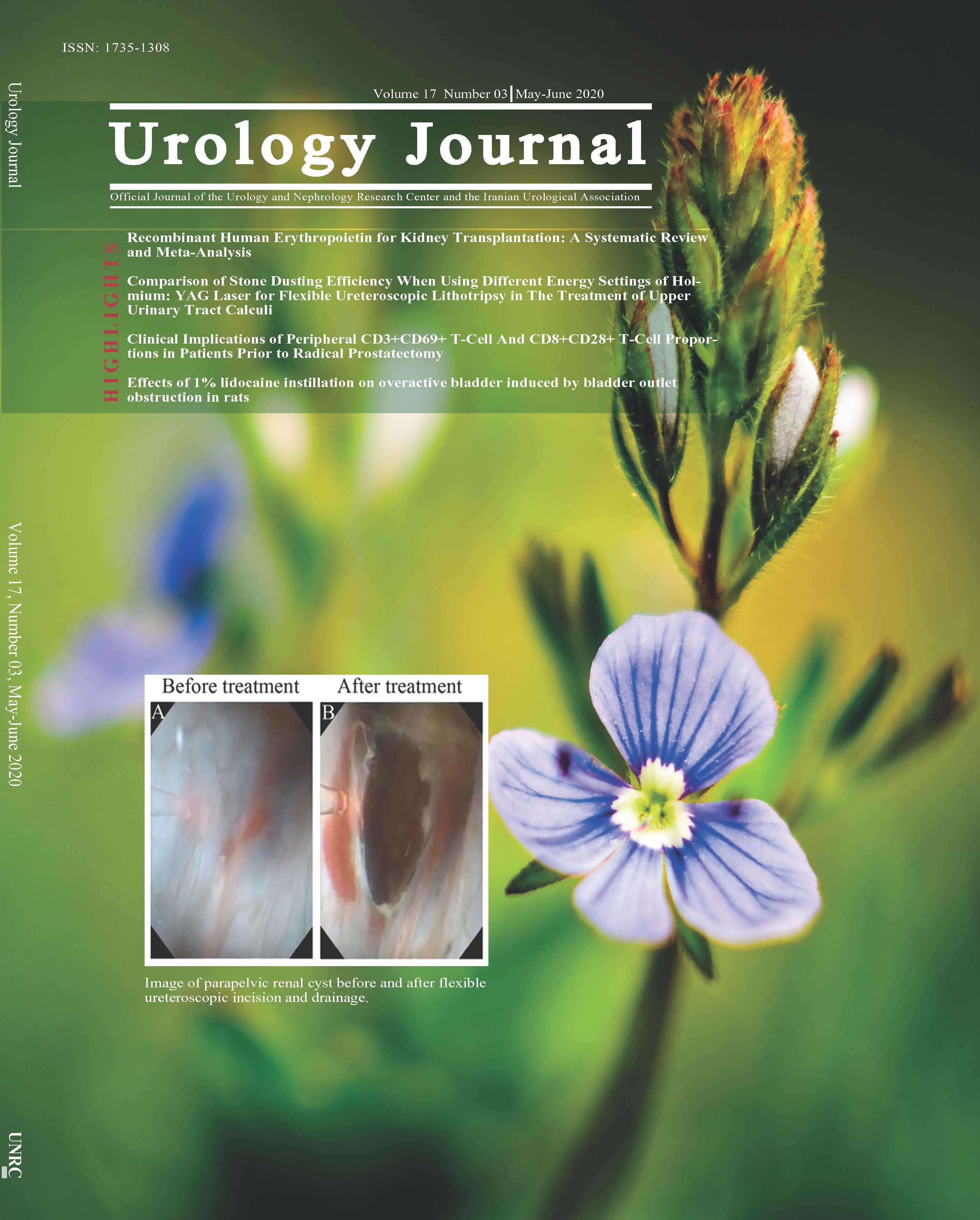Is RIRS Safe and Efficient In Patients With Kidney Stones Who Had Previous Open, Endoscopic, or Percutaneous Kidney Stone Surgery? One Center Retrospective Study
Urology Journal,
Vol. 17 No. 3 (2020),
16 May 2020
,
Page 228-231
https://doi.org/10.22037/uj.v17i3.4950
Abstract
Purpose: In our study, we assessed the efficiency and reliability of retrograde intrarenal surgery secondary to open surgery for kidney stone treatment. Moreover, we compared the efficiency and safety of retrograde intrarenal surgery for the patients with previous history of open surgery, percutaneous nephrolithotomy, secondary retrograde intrarenal surgery (RIRS) and primary RIRS.Materials and Methods: Data was retrospectively reviewed. Patients who had kidney anomalies, who had been stented due to ureteral stricture in the operation and who were < 18 years old, were excluded. There were 30 patients who underwent RIRS secondary to open surgery. The demographic and stone characteristic as well as intraoperative and postoperative data of the patients were recorded. 30 patients with similar demographic and stone characteristics to those patients were selected by match pairing method from patients who had previous PNL, RIRS history and had undergone primary RIRS. A total of 120 patients, in total 4 groups, were included in the study.
Results: Statistically significant difference was detected among the groups with regards to shock wave lithotripsy history and preoperative JJ stent rate. There was no statistically significant difference in terms of stone characteristics, intraoperative and postoperative data.
Conclusion: RIRS is an efficient and safe method for kidney stone treatment of the patients with previous history of open surgery, percutaneous nephrolithotomy and retrograde intrarenal surgery. It has a similar efficiency and safety for the patients who have undergone retrograde intrarenal surgery. This is the first study that compares the patients especially with different previous surgery methods.
- efficiency
- kidney stone
- previous surgery
- retrograde intrarenal surgery
- safety
How to Cite
References
Menon M, Resnick MI. Urinary Lithiasis: etiology, diagnosis, and medical management. Campbell’s Urology, Editor-in-chief: Patrick C. Walsh. Sounders, 2002, 8. Baskı, 96. Bölüm.
Honeck P, Wendt NG, Krombach P et al., “Does open stone surgery still play a role in the treatment of urolithiasis?Data of a primary urolithiasis center,” Journal of Endourology, vol. 23, no. 7, pp. 1209–1212, 2009.
Paik Ml, Resnick MI (2000) Is there a role for open stone surgery?Urol Clin North Am 27(2):323–331
Wendt NG, Mut T, Krombach P, Michel MS, Knoll T. Do new generation flexible ureterorenoscopes offer a higher treatment success than their predecessors? Urol Res. 2011;39:185–8.
Margel D, Lifshitz DA,Kugel V,Dorfmann D, Lask D, and Livne PM, “Percutaneous nephrolithotomy in patients who previously underwent open nephrolithotomy,” Journal of Endourology, vol. 19, no. 10, pp. 1161–1164, 2005.
Sofikerim M , Demirci D, Gulmez I, Karacagil M, “Does previous open nephrolithotomy affect the outcome of percutaneous nephrolithotomy?” Journal of Endourology, vol. 21, no. 4,
pp. 401–403, 2007.
Lojanapiwat B, “Previous open nephrolithotomy: does it affect percutaneous nephrolithotomy techniques and outcome?” Journalof Endourology, vol. 20, no. 1, pp. 17–20, 2006.
Gupta R, Gupta A, Singh G,Suri A,Mohan SK, Gupta CL, “PCNL A comparative study in nonoperated and in previously operated (open nephrolithotomy/pyelolithotomy) patients—a single surgeon experience,” International Brazilian Journal of Urology, vol. 37, no. 6, pp. 739–744, 2011.
Kim SC, Kuo RL, Lingeman JE, “Percutaneous nephrolithotomy: an update,” Current Opinion in Urology, vol. 13, no. 3, pp. 235–241, 2003.
Osman, M.M., Gamal, W.M., Gadelmoula, M.M. et al. Urol Res (2012) 40: 403. https://doi.org/10.1007/s00240-011-0435-1
Alkan E, Saribacak A, Ozkanli AO, Başar MM, Acar O, Balbay MD. Retrograde Intrarenal Surgery in Patients Who Previously Underwent Open Renal Stone Surgery. Minimally Invasive Surgery. 2015;2015:198765. doi:10.1155/2015/198765.
Kerbl K, Rehman J, Landman J, Lee D, Sundaram C, Clayman RV (2002) Current management of urolithiasis: progress or regress? J Endourol 16:281–288
Resorlu B, Unsal A, Gulec H, Oztuna D .A New Scoring System for Predicting Stone-free Rate After Retrograde Intrarenal Surgery: The “Resorlu-Unsal Stone Score” Urology , Volume 80 , Issue 3 , 512 - 518
Tonyalı Ş, Yılmaz M, Karaaslan M, Ceylan C, Işıkay L. Prediction of stone-free status after single-session retrograde intrarenal surgery for renal stones. Turk J Urol 2018; 44(6): 473-7.
Baş, O., Tuygun, C., Dede, O. et al. World J Urol (2017) 35: 819. https://doi.org/10.1007/s00345-016-1930-3
- Abstract Viewed: 636 times
- pdf/4950 Downloaded: 239 times
